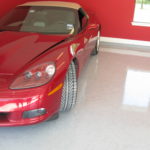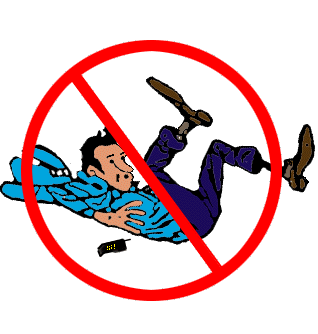Epoxy Floor Research, History and Education 101
At Slip Free Systems we believe an educated consumer is a happy customer. The more you know about the world of epoxy the better equipped you will be to choose a floor coating that is right for you. Of course, you don’t have to be an expert to get a quality coating but we understand that sometimes people like to have the facts and compare apples to apples.
 RESIDENTIAL: For instance, did you know that the epoxy used on your typical garage floor of a new home is different than what we often need for an older home? Older homes are more prone to moisture transmission so we often recommend a vapor barrier on homes built before 1983. Also, residential applications often lean towards a look that is more decorative.
RESIDENTIAL: For instance, did you know that the epoxy used on your typical garage floor of a new home is different than what we often need for an older home? Older homes are more prone to moisture transmission so we often recommend a vapor barrier on homes built before 1983. Also, residential applications often lean towards a look that is more decorative.
MARINE: Just as different products are used on concrete a different product is used for marinevessels as they are generally made of steel rather than cement. Ships, barges and other marine applications also require a more flexible surface as they move through the water.
COMMERCIAL & INDUSTRIAL: Commercial applications often focus on functionality such as light reflectivity, no slip, anti-microbial properties and ease of cleaning as well as safety.

The overall cost will depend on a number of factors, including the square footage, color and if repairs are needed in the concrete before the epoxy is applied.
While the cost is a major consideration, it’s well worth it. Here’s why.
Durable and long-lasting
Epoxy flooring is highly durable and will last for years to come. With other options, you’ll find you must reapply the paint frequently to keep the floors looking great. With epoxy, you won’t have to touch your floors again for years after the coating is applied. This restaurant, LaCasita in Pearland, TX was coated by Slip Free Systems, Inc in 1998 and with chairs moving back and forth every day by hundreds of customer the floor still looks great!

Protection for your floor
An epoxy coating will also protect the floors of your garage or home and make them easier to clean. You’ll be able to work on your car in the garage and not worry about any more oil stains on the floor. And the floor will endure all the wear and tear you can throw at it. Epoxy flooring is resistant to chemicals so regardless of what type of work you do in the garage, your floor will be safe from harm.
Value
Epoxy flooring can increase the value of your home or business. Potential buyers will love to have durable, shiny, clean, light reflective garage floors and might be willing to pay a higher price for a home or business with this type of flooring.
Safety
Epoxy floors are resistant to slippage, temperature fluctuations, extreme impact and even fire. That means your family remains safe in your home, and your employees will have no reason to sue for accidents as a result of negligence regardless of the type of work going on in the garage or your business.
Variety
Epoxy is a great choice to decorate your floors as well. It’s available in a variety of colors that add a flawless, smooth, elegant shine elegant shine. The flooring can also be arranged into traditional or personalized patterns and designs. The number of choices makes it an economical way to upgrade plain concrete and improve the ambiance of a home or office. Even industrial warehouses benefit from the array of color and texture options to mark isles and pedestrian areas or even match a company theme.
Protective
Epoxy flooring protects the underlying concrete from moisture, stains, grease and cracks. In the long run, this can save you a great deal on cleaning and maintenance costs by eliminating the need to clean carpet or grout. It’s also very reasonably priced for the duration and level of protection that it offers.
Resistance
Epoxy floors are highly resistant to just about everything – oil, gasoline, bleach, transmission fluid, cleansers and more. This is one the main reasons they’re frequently used in garages and within the automotive industry. Besides withstanding chemical spills/cleaners, epoxy floor coating is also heat and water-resistant. They are almost impervious to most chemical spills without any negative effects on the coating.
Another pro is that these floors also resistant to bacteria and germs, which makes them very easy to sanitize. This is why epoxy is an excellent choice for hospitals and clinics.
The truth is that Epoxy Paints and Epoxy Coatings are NOT one and the same.
Consumers began to use ‘Epoxy Coating’ and ‘Paint’ interchangeably. The more people began to say “Epoxy Paint,” the more manufacturers and retailers marketed their products as such. Typically, a garage floor paint is a latex acrylic product. Many of the well-known paint manufacturers do offer paint which is blended with epoxy resin and refer them to 1-part epoxy paint. This allows for better adhesion and durability, but is not an epoxy coating by any means.
What is an Epoxy Coating?
An Epoxy Coating is an epoxy resin combined with a polyamine hardener. The two have to be mixed together prior to being applied. Once mixed, you have only a certain amount of time to apply. When mixing you have to reach the right temperature and velocity in order to kickstart the chain reaction that causes the molecular change that allows the product to cure.
What percentage of solids should you look for?
This is the real question to ask when deciding the right product for you. Percentage of solids is what determines how easy the coating is to apply, how durable a finish you’ll end up with, and what you’ll be spending.
Essentially, percentage of solids means how much of the epoxy product (whether solvent or water-based) will evaporate during the curing process, and consequently, how much of the actual product will be on the floor in the form of protection when all is said and done.
100% solids epoxy— 100% of the product is on the floor after it’s applied and dried.
50% solids epoxy — 50% of the product is on the floor after it’s applied and dried.
The greater the percentage of solids, the thicker the final layer of protection. After all, the less that evaporates, the greater the layer of protection you’ll have left.
Dry Film Thickness (DFT) — In technical terms, the final thickness of your protection is known as DFT. The greater the solids content, the greater the DFT.
Are DIY Epoxy Paint Kits from typical Home Improvement Stores any good?
These kits are easy to buy, more affordable, and can be applied as easy as paint. So what’s the problem?
To begin with, they may not be a ‘true epoxy coating’. The main backbone chemistry may be latex based. They contain very low amount of solids content. So you’re getting what you pay for — a product that may be easier to apply, but because the solids content is so much lower, your protective coat will be much thinner. It might only give you a DFT of 4-5mils (1 mil = 1/1000th inch).
The real problem with these kits is that the thinner the coat, the less durable it is, and the lifespan of your garage floor finish will be short compared with an Epoxy coating with a higher solids content. The average lifespan these kits offer is only 1-2 years.
These kits are generally a low solids product, which means that when they are applied you may roll on 20 mils but after it dries you will be left with 3-7 mils of thickness. With a higher solids product if you put on 20 mils you will get 20 mils of thickness after it cures. The lower the solids the more like paint it is. With paint you are waiting for it to dry. With a true epoxy you are waiting for it to cure, similar to how plastic hardens.
So is a more expensive kit worth it?
Because of its higher solids content and the chemistry involved in formulating these products, it is considered a true Epoxy Coating. Slip Free Systems, Inc Epoxy Coatings give you a thicker, more durable, longer-lasting surface, and come in various color options. Another important factor is floor preparation. With DIY kits they often advise an acid wash as pre-preparation but because of laitance proper preparation must include diamond grinding or shotblasting to first remove the laitance and open up the pores of the concrete to receive the epoxy and allow for the greatest bond environment.
Because our quality Epoxy Coating lasts so much longer and won’t need to be replaced every few years, while initially more expensive, in the long run it will save you money.
Hot tire pick up resistance.
The third big advantage of a higher solids content coating is something called ‘hot tire pick up resistance’. Tires get hot. When you pull out a vehicle with hot tires on a garage floor with a thin, cheap coating, the paint will stick to the tire and pull it right off of the substrate. Our higher solids content coatings won’t stick and delaminate from the substrate when pulling out a vehicle that’s been parked all night due to the industrial nature of the formula and the floor preparation of shot blasting or diamond grinding.
WHAT IS EPOXY COVE BASE?
In any normal room, the place where the floor meets the wall is a 90 degree angle, but a cove base creates a smooth, sloping transition in this location. As part of a complete epoxy flooring system, a cove base allows the floor coating to also cover the bottom section of the wall, with no seams or breaks making cleaning easier but also blocking out voids where water or contaminants can seep under the wall and create problems. Cove is a preferred choice in commercial food service areas.
WHAT ARE THE ADVANTAGES OF EPOXY COVE BASE?
A 90-degree corner is normally hard to clean because a broom, mop or other cleaning tool cannot reach all the way to the meeting point. This allows dirt, mold, mildew and bacteria to reside and grow, unchecked. Especially in an environment where moisture is present, this leads to problems with bacterial growth.
Epoxy cove base, however, eliminates the tight corner by providing a sloped transition that is easy to clean and provides no refuge for contaminant growth. Especially when used in conjunction with antimicrobial flooring, an epoxy cove base will facilitate a cleaner, healthier workplace.
Click here to return to our home page.



